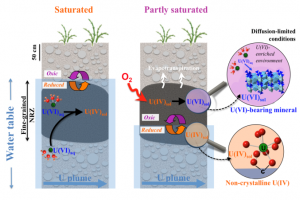Hexavalent Uranium Storage Mechanisms In Wet-Dry Cycled Sediments At Contaminated DOE Sites In The Western U.S.
By Noël V., Boye K., Kukkadapu R. K., Li Q., and Bargar J. R.

Noël, V.; Boye, K.; Kukkadapu, R. K.; Li, Q.; Bargar, J. R. Uranium storage mechanisms in wet-dry redox cycled sediments. Water Research. Water Research 152 (2019), 251-263; https://doi.org/10.1016/j.watres.2018.12.040

New process observed for uranium accumulation and release at contaminated DOE sites
Uranium is a major groundwater quality problem at contaminated former ore processing and nuclear complex sites across the United States. In the intermountain West, which hosts most of the U.S. legacy ore-processing sites, uranium groundwater plumes are not dissipating through the natural flushing by groundwater as originally expected. At many of these sites, uranium accumulates within organic-enriched, sulfidic sediments as sparingly-soluble U(IV). When water tables drop during summer drought, moisture drains away, and air enters sediment pore spaces, allowing oxygen to access and oxidize U(IV) and transform it into highly mobile U(VI). When this happens, organic-enriched sediments release uranium back to groundwater, helping to prolong plume longevity. Thus, seasonal water table fluctuations force a cascade of coupled biogeochemical processes that seasonally transform and release uranium, nutrients, and other contaminants to groundwater.
It widely believed that that oxidation of sediment-hosted U(IV) will lead to mobilization of uranium as U(VI). In this recent study, however, we show exactly the opposite behavior; that oxidation reactions driven by annual water table fluctuations cause U(VI) to become trapped in sediments. To investigate this issue, Noël et al. (2019) examined the occurrence, distribution, and stability of reduced and oxidized iron, sulfur, and uranium species in shallow sediments at the Shiprock, NM, site affected by annual water table fluctuations. The research used detailed molecular characterization involving X-ray absorption spectroscopy (XAS), Mössbauer spectroscopy and X-ray microspectroscopy. We found that, during the oxidation stage, sediment-hosted U(IV) is oxidized to sediment-hosted U(VI) faster than dissolved U(VI) can be transported away. Thus, within individual pores, dissolved U(VI) becomes more concentrated in solution over time, helped by low diffusion in fine-grained sediments and evapotranspiration. We posit that U(VI) eventually precipitates in solid phases that are kinetically stable against dissolution (Figure 1). Overall, this study shows that strong wet-dry and biogeochemical redox cycling is required to accumulate both U(IV) and U(VI) in low-permeability sediments. This behavior suggests, somewhat surprisingly, that low-permeability organic-enriched zones could provide long-term storage for U(VI), which has major environmental implications for floodplain water quality. This work corroborates previous observations that reducing conditions are needed to accumulate U in sediment solid-phases, but counters the expectation that U predominantly accumulates as U(IV).
